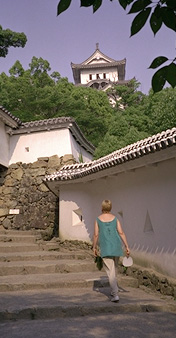
Bruce "Tog" Tognazzini.
|
|
Japan on $1000 per Day
Day 11: Castles in the SkyOkayama is our first stop today. Site of Korakuen garden, considered one of Japan’s three finest. It did not fit our image of Japanese gardens, spreading as it does across 28 acres, with vast expanses of manicured lawn.
Immediately outside the grounds and straight up is Okayama Castle, originally built in the 16th century and rebuilt in 1966. (It’s not some grand coincidence that all these venerable sites in Japan are so new; the Allies burned them all to the ground during the War. It seems the Japanese military in World War II liked setting up their headquarters in the castles.)
The new castle is pre-stressed concrete disguised as wood. It was attractive and informative, but it will be 100 years at least before it is interesting. Back on the bullet train. I was jealous. A kid two seats ahead on the other side is watching TV. A nice little 5" flat-panel job. Funny how he can get it to stand up in the air on its little arm like that. It’s almost as though it is attached to the seat. Wait a minute! It is attached to the seat! I flipped open my center armrest and tucked inside, where an airliner might have had a tray table, was my own personal TV set, with a perfect color image. If I’d thought ahead, I would have brought my own headphones to plug into the audio channel. But then I would have had to think really, really far ahead, because first, to understand the dialog, I would have had to learn Japanese.
We had not been able to find out whether there would be lockers available for our suitcases in the station. Therefore, as a back-up plan, we had found a nearby first-class hotel in our guidebook to which we would drag our luggage for temporary storage. This technique has served us well in Europe. As it turned out, lockers were readily available. Himeji Castle was left untouched by World War II, and it is breathtaking. I mean that literally. It is on a hill about 25,000 feet straight up from the city, and is over 1236 stories tall. Or at least it felt that way in the 195° weather. As you creep its halls in slippered feet, you cannot fail to be in awe of the souls who lived and fought and died along its polished-wood corridors. The castle climbs into the sky for story after story, each one a masterpiece of the carpenter’s art. We left hot, exhausted, and reluctantly. Another half-movie on the train and we were in Kyoto, San Francisco’s sister city. Kyoto is famed for its beautiful garden and its country inns that attract the more adventurous gaijin to their ancient serenity. We had expected a town of quiet grace and greenery, but what we found was another downtown Reno look-alike, just like all the others. Kyoto was the capital of Japan for hundreds of years, until a few centuries ago when some upstart decided to move north to Tokyo. He left behind a city of beautiful wooden buildings. Periodically a block or ten would burn down, but other than these small irritations, the city survived in much its ancient form until recent years. The Allies never bombed Kyoto, although at one time it was on the short list, along with Hiroshima, for the first atomic bomb. Kyoto survived World War II absolutely intact, but apparently that upset the sense of symmetry of some Japanese folk, because they have been destroying the old Kyoto house-by-house, block-by-block ever since. For all the talk of the wonderful old wooden houses of Kyoto, we were hard-pressed to find them. Yes, you could find a cluster of two or three of them here, there, and everywhere, but always they were surrounded by the souless scourge of the bauhaus and the ever-present pulsing of neon. The operation of replacing the old with the mediocre has not been nearly as relentless as in Singapore, but the Kyotoites seem to be getting the job done. By now it is nightfall, but tomorrow we will do a little deer huntin', Nara-style. Stay tuned... Last Month: Day 10: Hiroshima, and all that that entails Next Month: Day 12: Where the Deer and Bon Jovi Play |


